Detailed Analysis of the Victor Harbor Community Plan 2036 and Goals
VerifiedAdded on 2022/09/17
|9
|2065
|33
Report
AI Summary
This report provides a comprehensive analysis of the Victor Harbor Community Plan 2036, focusing on its objectives, target groups, and strategic interventions. The report begins with an introduction to the plan, which aims to shape the city's future for the next twenty years. It identifies the council's vision and the challenges faced in achieving its goals. The analysis delves into the theoretical underpinnings of the plan, the key objectives, and the identified target groups, including both direct and indirect stakeholders. It examines the evidence base supporting the plan's development, including consultations, infrastructure assessments, and environmental reviews. Furthermore, the report outlines the key interventions proposed by the council, such as environmental protection, infrastructure development, and community engagement initiatives. Finally, it discusses the evaluation and monitoring strategies employed to measure the plan's effectiveness, including collaborations with other agencies and community-led initiatives. The report concludes by summarizing the plan's key components and emphasizing the role of various stakeholders in achieving the set goals.
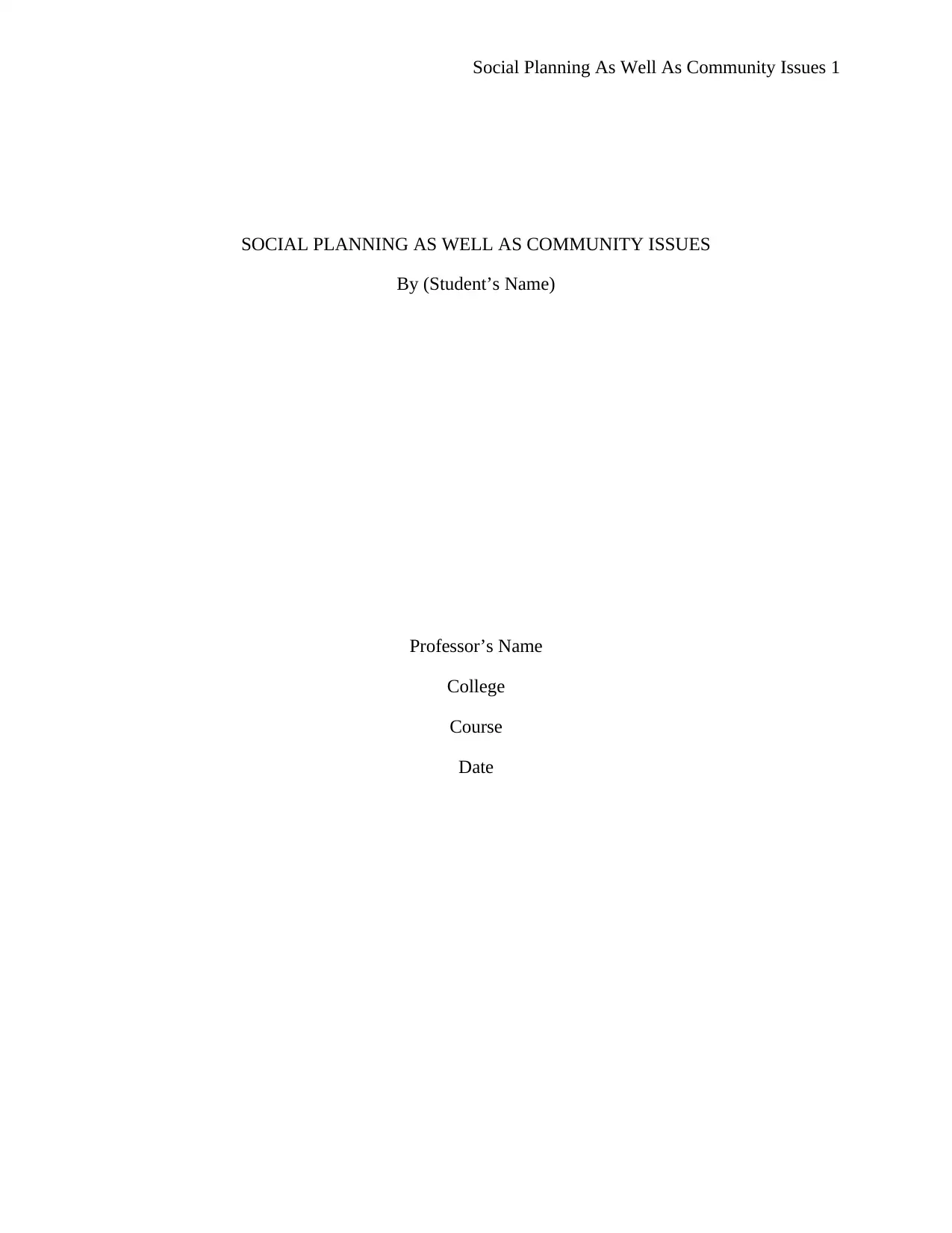
Social Planning As Well As Community Issues 1
SOCIAL PLANNING AS WELL AS COMMUNITY ISSUES
By (Student’s Name)
Professor’s Name
College
Course
Date
SOCIAL PLANNING AS WELL AS COMMUNITY ISSUES
By (Student’s Name)
Professor’s Name
College
Course
Date
Paraphrase This Document
Need a fresh take? Get an instant paraphrase of this document with our AI Paraphraser
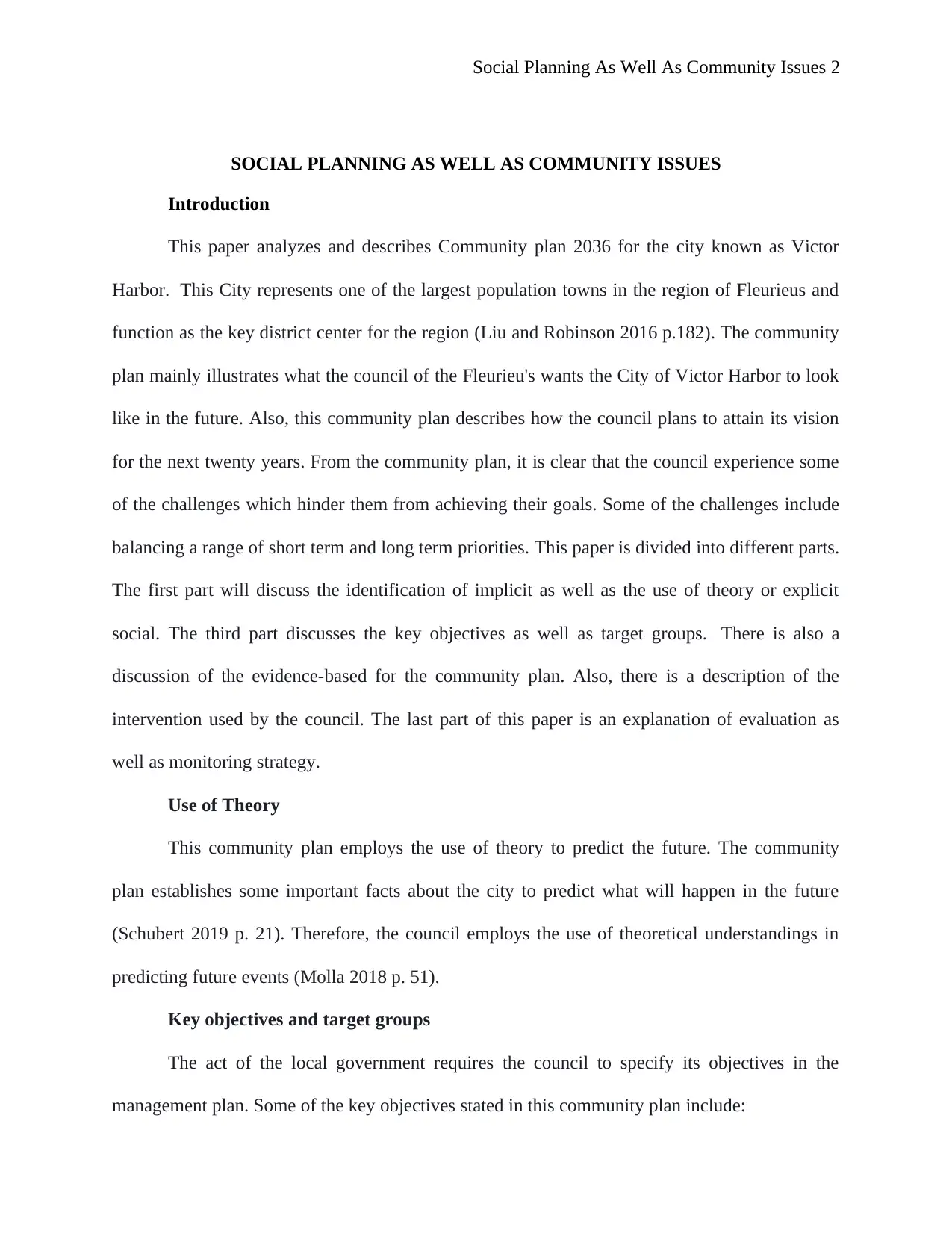
Social Planning As Well As Community Issues 2
SOCIAL PLANNING AS WELL AS COMMUNITY ISSUES
Introduction
This paper analyzes and describes Community plan 2036 for the city known as Victor
Harbor. This City represents one of the largest population towns in the region of Fleurieus and
function as the key district center for the region (Liu and Robinson 2016 p.182). The community
plan mainly illustrates what the council of the Fleurieu's wants the City of Victor Harbor to look
like in the future. Also, this community plan describes how the council plans to attain its vision
for the next twenty years. From the community plan, it is clear that the council experience some
of the challenges which hinder them from achieving their goals. Some of the challenges include
balancing a range of short term and long term priorities. This paper is divided into different parts.
The first part will discuss the identification of implicit as well as the use of theory or explicit
social. The third part discusses the key objectives as well as target groups. There is also a
discussion of the evidence-based for the community plan. Also, there is a description of the
intervention used by the council. The last part of this paper is an explanation of evaluation as
well as monitoring strategy.
Use of Theory
This community plan employs the use of theory to predict the future. The community
plan establishes some important facts about the city to predict what will happen in the future
(Schubert 2019 p. 21). Therefore, the council employs the use of theoretical understandings in
predicting future events (Molla 2018 p. 51).
Key objectives and target groups
The act of the local government requires the council to specify its objectives in the
management plan. Some of the key objectives stated in this community plan include:
SOCIAL PLANNING AS WELL AS COMMUNITY ISSUES
Introduction
This paper analyzes and describes Community plan 2036 for the city known as Victor
Harbor. This City represents one of the largest population towns in the region of Fleurieus and
function as the key district center for the region (Liu and Robinson 2016 p.182). The community
plan mainly illustrates what the council of the Fleurieu's wants the City of Victor Harbor to look
like in the future. Also, this community plan describes how the council plans to attain its vision
for the next twenty years. From the community plan, it is clear that the council experience some
of the challenges which hinder them from achieving their goals. Some of the challenges include
balancing a range of short term and long term priorities. This paper is divided into different parts.
The first part will discuss the identification of implicit as well as the use of theory or explicit
social. The third part discusses the key objectives as well as target groups. There is also a
discussion of the evidence-based for the community plan. Also, there is a description of the
intervention used by the council. The last part of this paper is an explanation of evaluation as
well as monitoring strategy.
Use of Theory
This community plan employs the use of theory to predict the future. The community
plan establishes some important facts about the city to predict what will happen in the future
(Schubert 2019 p. 21). Therefore, the council employs the use of theoretical understandings in
predicting future events (Molla 2018 p. 51).
Key objectives and target groups
The act of the local government requires the council to specify its objectives in the
management plan. Some of the key objectives stated in this community plan include:
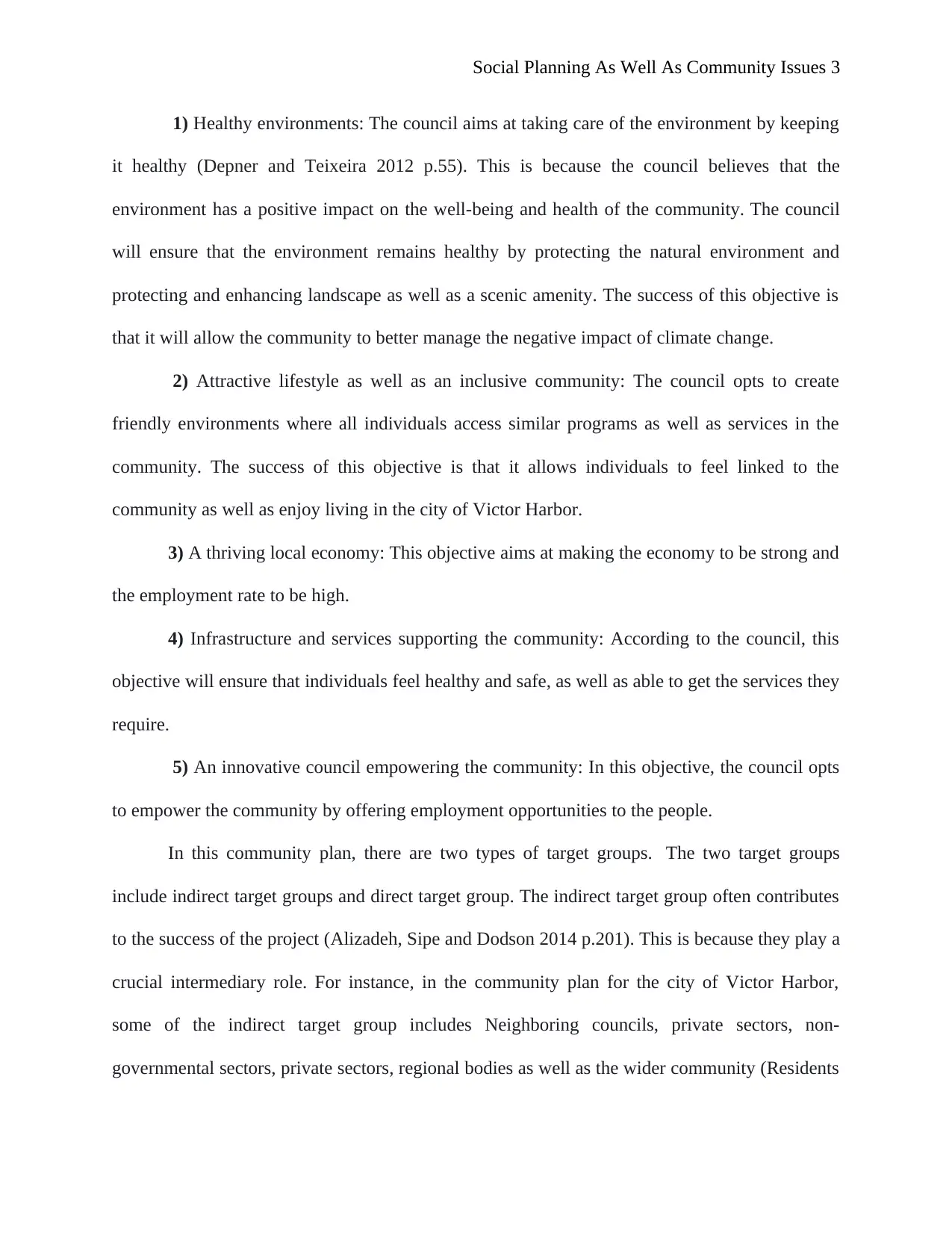
Social Planning As Well As Community Issues 3
1) Healthy environments: The council aims at taking care of the environment by keeping
it healthy (Depner and Teixeira 2012 p.55). This is because the council believes that the
environment has a positive impact on the well-being and health of the community. The council
will ensure that the environment remains healthy by protecting the natural environment and
protecting and enhancing landscape as well as a scenic amenity. The success of this objective is
that it will allow the community to better manage the negative impact of climate change.
2) Attractive lifestyle as well as an inclusive community: The council opts to create
friendly environments where all individuals access similar programs as well as services in the
community. The success of this objective is that it allows individuals to feel linked to the
community as well as enjoy living in the city of Victor Harbor.
3) A thriving local economy: This objective aims at making the economy to be strong and
the employment rate to be high.
4) Infrastructure and services supporting the community: According to the council, this
objective will ensure that individuals feel healthy and safe, as well as able to get the services they
require.
5) An innovative council empowering the community: In this objective, the council opts
to empower the community by offering employment opportunities to the people.
In this community plan, there are two types of target groups. The two target groups
include indirect target groups and direct target group. The indirect target group often contributes
to the success of the project (Alizadeh, Sipe and Dodson 2014 p.201). This is because they play a
crucial intermediary role. For instance, in the community plan for the city of Victor Harbor,
some of the indirect target group includes Neighboring councils, private sectors, non-
governmental sectors, private sectors, regional bodies as well as the wider community (Residents
1) Healthy environments: The council aims at taking care of the environment by keeping
it healthy (Depner and Teixeira 2012 p.55). This is because the council believes that the
environment has a positive impact on the well-being and health of the community. The council
will ensure that the environment remains healthy by protecting the natural environment and
protecting and enhancing landscape as well as a scenic amenity. The success of this objective is
that it will allow the community to better manage the negative impact of climate change.
2) Attractive lifestyle as well as an inclusive community: The council opts to create
friendly environments where all individuals access similar programs as well as services in the
community. The success of this objective is that it allows individuals to feel linked to the
community as well as enjoy living in the city of Victor Harbor.
3) A thriving local economy: This objective aims at making the economy to be strong and
the employment rate to be high.
4) Infrastructure and services supporting the community: According to the council, this
objective will ensure that individuals feel healthy and safe, as well as able to get the services they
require.
5) An innovative council empowering the community: In this objective, the council opts
to empower the community by offering employment opportunities to the people.
In this community plan, there are two types of target groups. The two target groups
include indirect target groups and direct target group. The indirect target group often contributes
to the success of the project (Alizadeh, Sipe and Dodson 2014 p.201). This is because they play a
crucial intermediary role. For instance, in the community plan for the city of Victor Harbor,
some of the indirect target group includes Neighboring councils, private sectors, non-
governmental sectors, private sectors, regional bodies as well as the wider community (Residents
You're viewing a preview
Unlock full access by subscribing today!
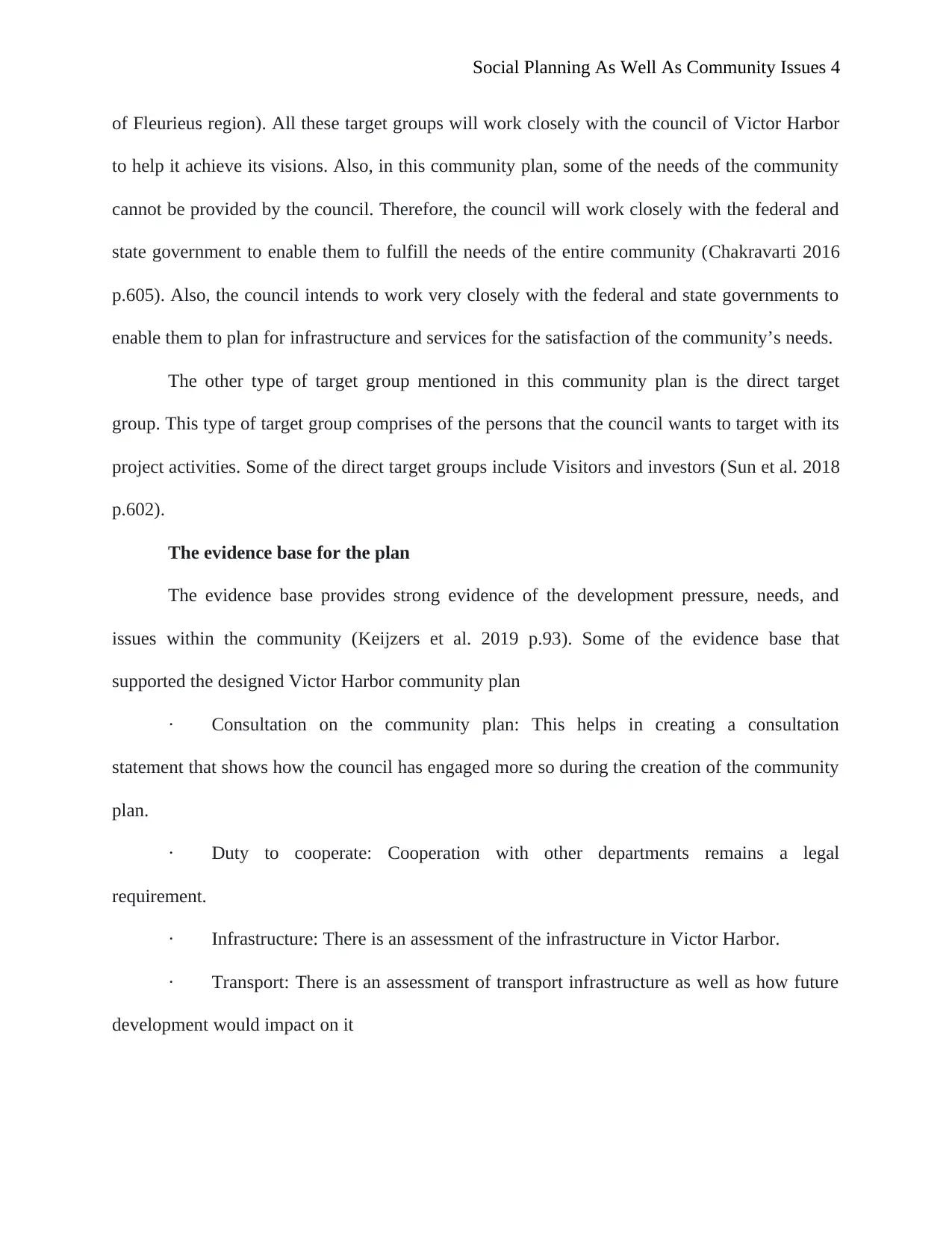
Social Planning As Well As Community Issues 4
of Fleurieus region). All these target groups will work closely with the council of Victor Harbor
to help it achieve its visions. Also, in this community plan, some of the needs of the community
cannot be provided by the council. Therefore, the council will work closely with the federal and
state government to enable them to fulfill the needs of the entire community (Chakravarti 2016
p.605). Also, the council intends to work very closely with the federal and state governments to
enable them to plan for infrastructure and services for the satisfaction of the community’s needs.
The other type of target group mentioned in this community plan is the direct target
group. This type of target group comprises of the persons that the council wants to target with its
project activities. Some of the direct target groups include Visitors and investors (Sun et al. 2018
p.602).
The evidence base for the plan
The evidence base provides strong evidence of the development pressure, needs, and
issues within the community (Keijzers et al. 2019 p.93). Some of the evidence base that
supported the designed Victor Harbor community plan
· Consultation on the community plan: This helps in creating a consultation
statement that shows how the council has engaged more so during the creation of the community
plan.
· Duty to cooperate: Cooperation with other departments remains a legal
requirement.
· Infrastructure: There is an assessment of the infrastructure in Victor Harbor.
· Transport: There is an assessment of transport infrastructure as well as how future
development would impact on it
of Fleurieus region). All these target groups will work closely with the council of Victor Harbor
to help it achieve its visions. Also, in this community plan, some of the needs of the community
cannot be provided by the council. Therefore, the council will work closely with the federal and
state government to enable them to fulfill the needs of the entire community (Chakravarti 2016
p.605). Also, the council intends to work very closely with the federal and state governments to
enable them to plan for infrastructure and services for the satisfaction of the community’s needs.
The other type of target group mentioned in this community plan is the direct target
group. This type of target group comprises of the persons that the council wants to target with its
project activities. Some of the direct target groups include Visitors and investors (Sun et al. 2018
p.602).
The evidence base for the plan
The evidence base provides strong evidence of the development pressure, needs, and
issues within the community (Keijzers et al. 2019 p.93). Some of the evidence base that
supported the designed Victor Harbor community plan
· Consultation on the community plan: This helps in creating a consultation
statement that shows how the council has engaged more so during the creation of the community
plan.
· Duty to cooperate: Cooperation with other departments remains a legal
requirement.
· Infrastructure: There is an assessment of the infrastructure in Victor Harbor.
· Transport: There is an assessment of transport infrastructure as well as how future
development would impact on it
Paraphrase This Document
Need a fresh take? Get an instant paraphrase of this document with our AI Paraphraser
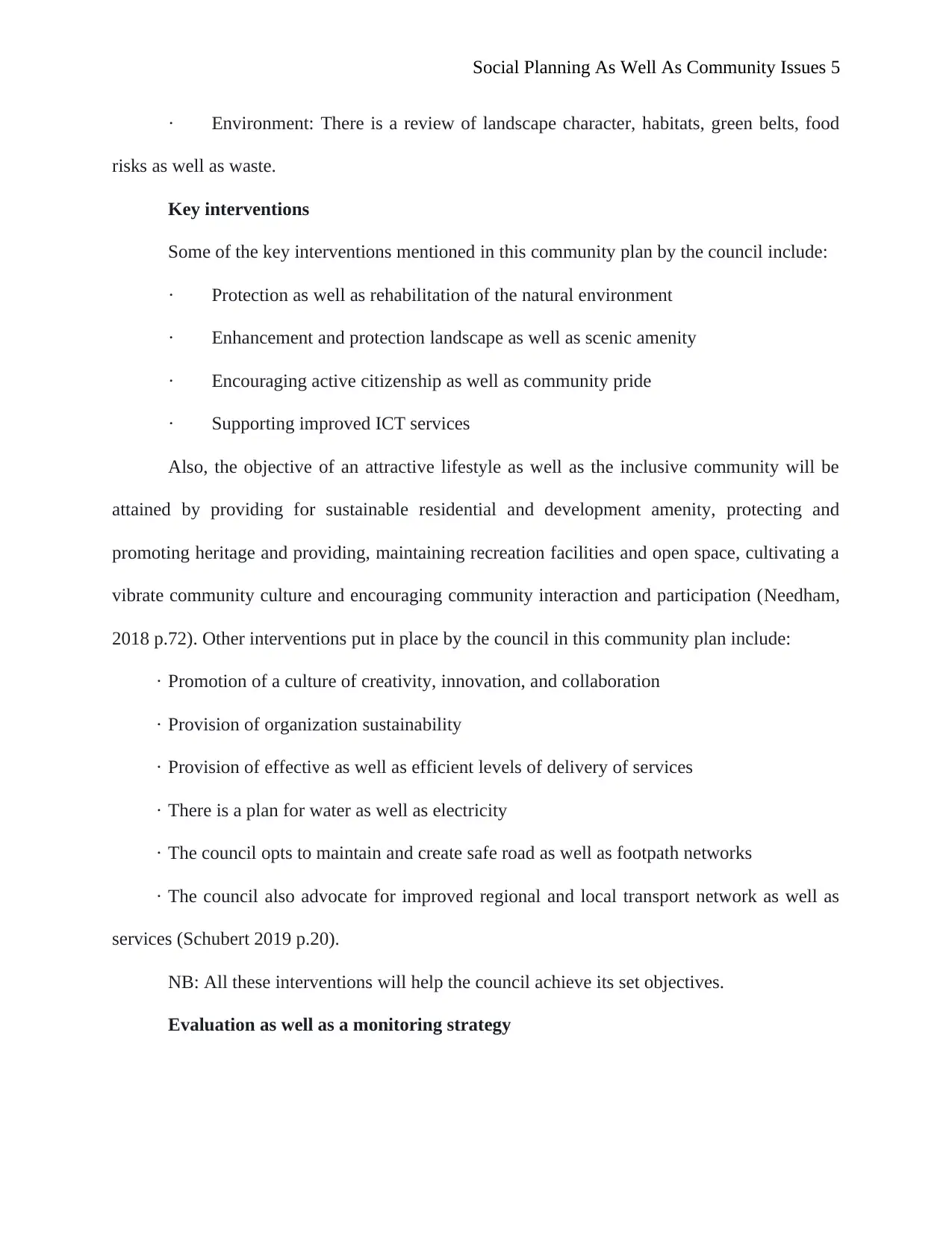
Social Planning As Well As Community Issues 5
· Environment: There is a review of landscape character, habitats, green belts, food
risks as well as waste.
Key interventions
Some of the key interventions mentioned in this community plan by the council include:
· Protection as well as rehabilitation of the natural environment
· Enhancement and protection landscape as well as scenic amenity
· Encouraging active citizenship as well as community pride
· Supporting improved ICT services
Also, the objective of an attractive lifestyle as well as the inclusive community will be
attained by providing for sustainable residential and development amenity, protecting and
promoting heritage and providing, maintaining recreation facilities and open space, cultivating a
vibrate community culture and encouraging community interaction and participation (Needham,
2018 p.72). Other interventions put in place by the council in this community plan include:
· Promotion of a culture of creativity, innovation, and collaboration
· Provision of organization sustainability
· Provision of effective as well as efficient levels of delivery of services
· There is a plan for water as well as electricity
· The council opts to maintain and create safe road as well as footpath networks
· The council also advocate for improved regional and local transport network as well as
services (Schubert 2019 p.20).
NB: All these interventions will help the council achieve its set objectives.
Evaluation as well as a monitoring strategy
· Environment: There is a review of landscape character, habitats, green belts, food
risks as well as waste.
Key interventions
Some of the key interventions mentioned in this community plan by the council include:
· Protection as well as rehabilitation of the natural environment
· Enhancement and protection landscape as well as scenic amenity
· Encouraging active citizenship as well as community pride
· Supporting improved ICT services
Also, the objective of an attractive lifestyle as well as the inclusive community will be
attained by providing for sustainable residential and development amenity, protecting and
promoting heritage and providing, maintaining recreation facilities and open space, cultivating a
vibrate community culture and encouraging community interaction and participation (Needham,
2018 p.72). Other interventions put in place by the council in this community plan include:
· Promotion of a culture of creativity, innovation, and collaboration
· Provision of organization sustainability
· Provision of effective as well as efficient levels of delivery of services
· There is a plan for water as well as electricity
· The council opts to maintain and create safe road as well as footpath networks
· The council also advocate for improved regional and local transport network as well as
services (Schubert 2019 p.20).
NB: All these interventions will help the council achieve its set objectives.
Evaluation as well as a monitoring strategy
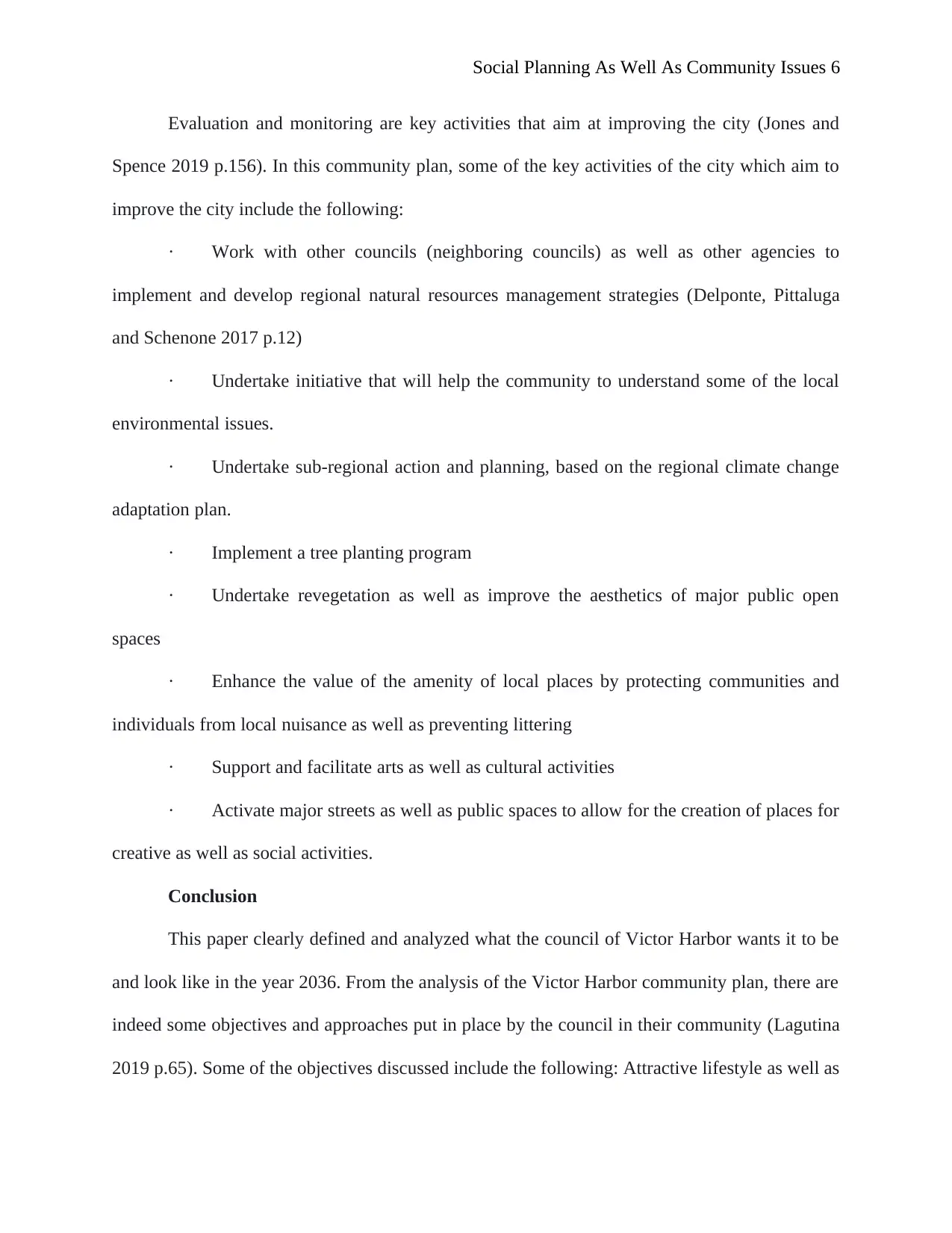
Social Planning As Well As Community Issues 6
Evaluation and monitoring are key activities that aim at improving the city (Jones and
Spence 2019 p.156). In this community plan, some of the key activities of the city which aim to
improve the city include the following:
· Work with other councils (neighboring councils) as well as other agencies to
implement and develop regional natural resources management strategies (Delponte, Pittaluga
and Schenone 2017 p.12)
· Undertake initiative that will help the community to understand some of the local
environmental issues.
· Undertake sub-regional action and planning, based on the regional climate change
adaptation plan.
· Implement a tree planting program
· Undertake revegetation as well as improve the aesthetics of major public open
spaces
· Enhance the value of the amenity of local places by protecting communities and
individuals from local nuisance as well as preventing littering
· Support and facilitate arts as well as cultural activities
· Activate major streets as well as public spaces to allow for the creation of places for
creative as well as social activities.
Conclusion
This paper clearly defined and analyzed what the council of Victor Harbor wants it to be
and look like in the year 2036. From the analysis of the Victor Harbor community plan, there are
indeed some objectives and approaches put in place by the council in their community (Lagutina
2019 p.65). Some of the objectives discussed include the following: Attractive lifestyle as well as
Evaluation and monitoring are key activities that aim at improving the city (Jones and
Spence 2019 p.156). In this community plan, some of the key activities of the city which aim to
improve the city include the following:
· Work with other councils (neighboring councils) as well as other agencies to
implement and develop regional natural resources management strategies (Delponte, Pittaluga
and Schenone 2017 p.12)
· Undertake initiative that will help the community to understand some of the local
environmental issues.
· Undertake sub-regional action and planning, based on the regional climate change
adaptation plan.
· Implement a tree planting program
· Undertake revegetation as well as improve the aesthetics of major public open
spaces
· Enhance the value of the amenity of local places by protecting communities and
individuals from local nuisance as well as preventing littering
· Support and facilitate arts as well as cultural activities
· Activate major streets as well as public spaces to allow for the creation of places for
creative as well as social activities.
Conclusion
This paper clearly defined and analyzed what the council of Victor Harbor wants it to be
and look like in the year 2036. From the analysis of the Victor Harbor community plan, there are
indeed some objectives and approaches put in place by the council in their community (Lagutina
2019 p.65). Some of the objectives discussed include the following: Attractive lifestyle as well as
You're viewing a preview
Unlock full access by subscribing today!

Social Planning As Well As Community Issues 7
the inclusive community; a thriving local economy; Infrastructure and services supporting the
community; Healthy environments; and innovative council empowering the community. The
plan also discussed some of the methods that the council will use to achieve the set objectives.
This paper also stated some of the important stakeholders that will help the council realize the set
goals and visions. The essential stakeholders mentioned in the plan include Neighboring
councils, private sectors, non-governmental sectors, private sectors, and regional bodies, federal
and state governments. All these stakeholders will provide the necessary resources for the
achievement of the set goals.
the inclusive community; a thriving local economy; Infrastructure and services supporting the
community; Healthy environments; and innovative council empowering the community. The
plan also discussed some of the methods that the council will use to achieve the set objectives.
This paper also stated some of the important stakeholders that will help the council realize the set
goals and visions. The essential stakeholders mentioned in the plan include Neighboring
councils, private sectors, non-governmental sectors, private sectors, and regional bodies, federal
and state governments. All these stakeholders will provide the necessary resources for the
achievement of the set goals.
Paraphrase This Document
Need a fresh take? Get an instant paraphrase of this document with our AI Paraphraser
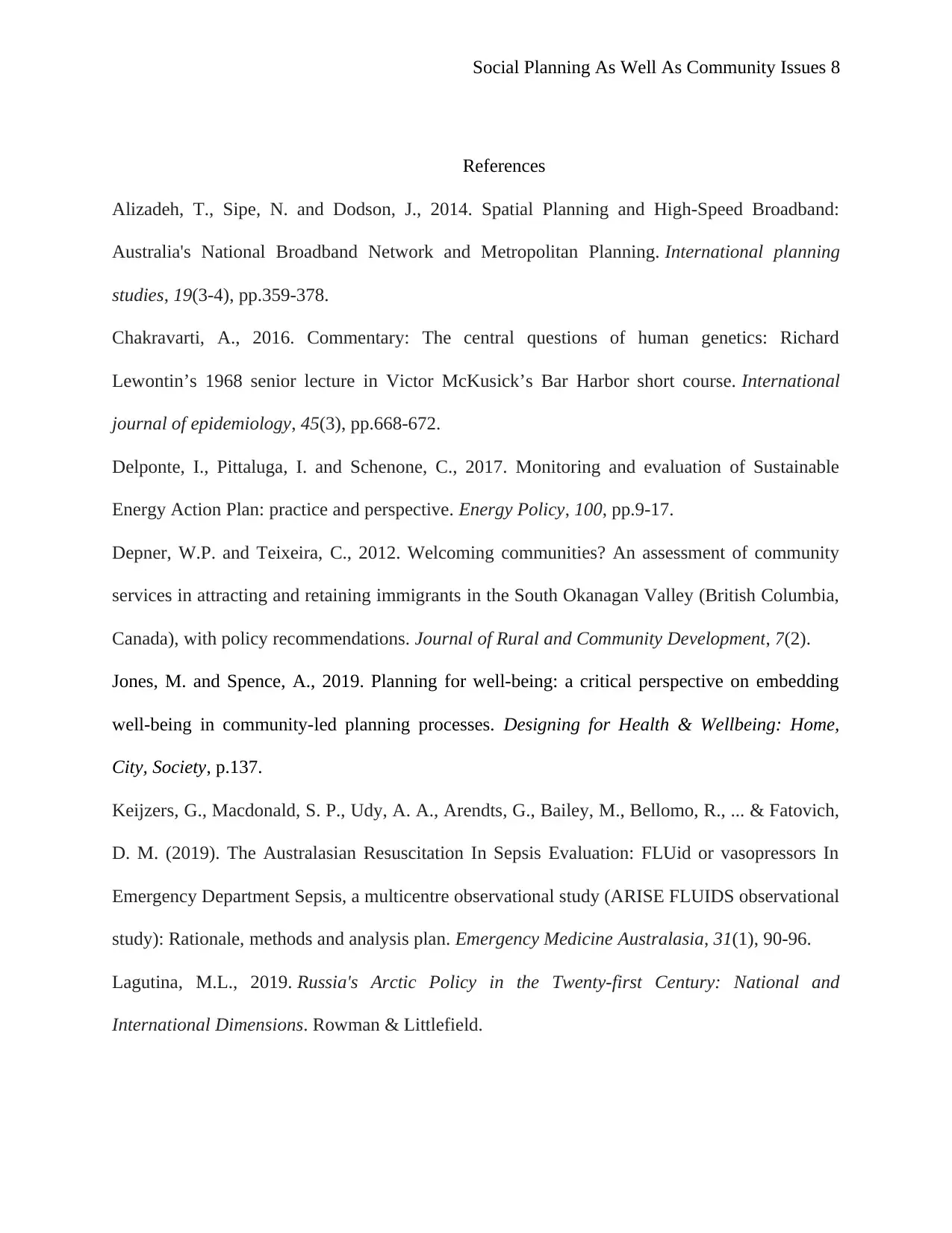
Social Planning As Well As Community Issues 8
References
Alizadeh, T., Sipe, N. and Dodson, J., 2014. Spatial Planning and High-Speed Broadband:
Australia's National Broadband Network and Metropolitan Planning. International planning
studies, 19(3-4), pp.359-378.
Chakravarti, A., 2016. Commentary: The central questions of human genetics: Richard
Lewontin’s 1968 senior lecture in Victor McKusick’s Bar Harbor short course. International
journal of epidemiology, 45(3), pp.668-672.
Delponte, I., Pittaluga, I. and Schenone, C., 2017. Monitoring and evaluation of Sustainable
Energy Action Plan: practice and perspective. Energy Policy, 100, pp.9-17.
Depner, W.P. and Teixeira, C., 2012. Welcoming communities? An assessment of community
services in attracting and retaining immigrants in the South Okanagan Valley (British Columbia,
Canada), with policy recommendations. Journal of Rural and Community Development, 7(2).
Jones, M. and Spence, A., 2019. Planning for well-being: a critical perspective on embedding
well-being in community-led planning processes. Designing for Health & Wellbeing: Home,
City, Society, p.137.
Keijzers, G., Macdonald, S. P., Udy, A. A., Arendts, G., Bailey, M., Bellomo, R., ... & Fatovich,
D. M. (2019). The Australasian Resuscitation In Sepsis Evaluation: FLUid or vasopressors In
Emergency Department Sepsis, a multicentre observational study (ARISE FLUIDS observational
study): Rationale, methods and analysis plan. Emergency Medicine Australasia, 31(1), 90-96.
Lagutina, M.L., 2019. Russia's Arctic Policy in the Twenty-first Century: National and
International Dimensions. Rowman & Littlefield.
References
Alizadeh, T., Sipe, N. and Dodson, J., 2014. Spatial Planning and High-Speed Broadband:
Australia's National Broadband Network and Metropolitan Planning. International planning
studies, 19(3-4), pp.359-378.
Chakravarti, A., 2016. Commentary: The central questions of human genetics: Richard
Lewontin’s 1968 senior lecture in Victor McKusick’s Bar Harbor short course. International
journal of epidemiology, 45(3), pp.668-672.
Delponte, I., Pittaluga, I. and Schenone, C., 2017. Monitoring and evaluation of Sustainable
Energy Action Plan: practice and perspective. Energy Policy, 100, pp.9-17.
Depner, W.P. and Teixeira, C., 2012. Welcoming communities? An assessment of community
services in attracting and retaining immigrants in the South Okanagan Valley (British Columbia,
Canada), with policy recommendations. Journal of Rural and Community Development, 7(2).
Jones, M. and Spence, A., 2019. Planning for well-being: a critical perspective on embedding
well-being in community-led planning processes. Designing for Health & Wellbeing: Home,
City, Society, p.137.
Keijzers, G., Macdonald, S. P., Udy, A. A., Arendts, G., Bailey, M., Bellomo, R., ... & Fatovich,
D. M. (2019). The Australasian Resuscitation In Sepsis Evaluation: FLUid or vasopressors In
Emergency Department Sepsis, a multicentre observational study (ARISE FLUIDS observational
study): Rationale, methods and analysis plan. Emergency Medicine Australasia, 31(1), 90-96.
Lagutina, M.L., 2019. Russia's Arctic Policy in the Twenty-first Century: National and
International Dimensions. Rowman & Littlefield.
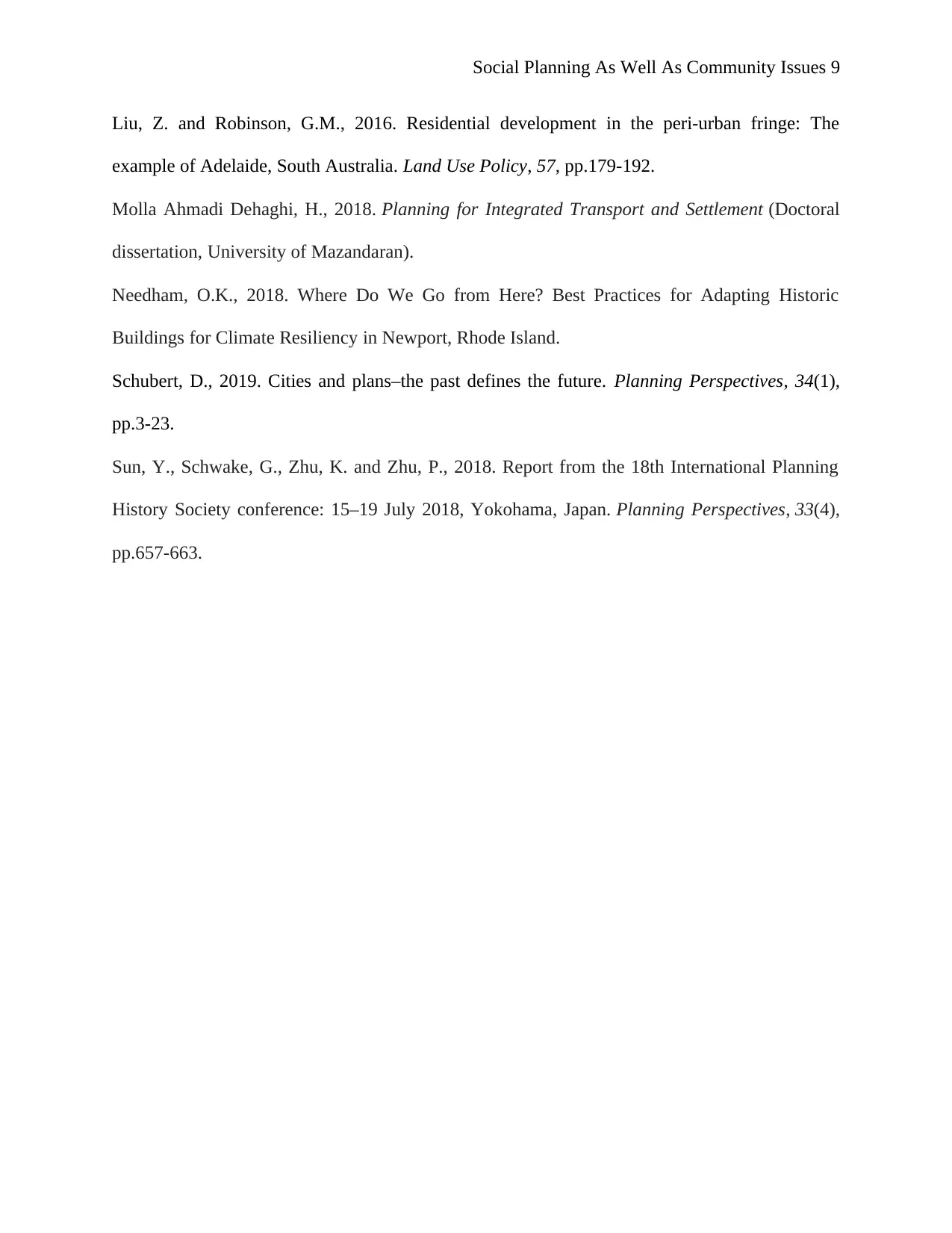
Social Planning As Well As Community Issues 9
Liu, Z. and Robinson, G.M., 2016. Residential development in the peri-urban fringe: The
example of Adelaide, South Australia. Land Use Policy, 57, pp.179-192.
Molla Ahmadi Dehaghi, H., 2018. Planning for Integrated Transport and Settlement (Doctoral
dissertation, University of Mazandaran).
Needham, O.K., 2018. Where Do We Go from Here? Best Practices for Adapting Historic
Buildings for Climate Resiliency in Newport, Rhode Island.
Schubert, D., 2019. Cities and plans–the past defines the future. Planning Perspectives, 34(1),
pp.3-23.
Sun, Y., Schwake, G., Zhu, K. and Zhu, P., 2018. Report from the 18th International Planning
History Society conference: 15–19 July 2018, Yokohama, Japan. Planning Perspectives, 33(4),
pp.657-663.
Liu, Z. and Robinson, G.M., 2016. Residential development in the peri-urban fringe: The
example of Adelaide, South Australia. Land Use Policy, 57, pp.179-192.
Molla Ahmadi Dehaghi, H., 2018. Planning for Integrated Transport and Settlement (Doctoral
dissertation, University of Mazandaran).
Needham, O.K., 2018. Where Do We Go from Here? Best Practices for Adapting Historic
Buildings for Climate Resiliency in Newport, Rhode Island.
Schubert, D., 2019. Cities and plans–the past defines the future. Planning Perspectives, 34(1),
pp.3-23.
Sun, Y., Schwake, G., Zhu, K. and Zhu, P., 2018. Report from the 18th International Planning
History Society conference: 15–19 July 2018, Yokohama, Japan. Planning Perspectives, 33(4),
pp.657-663.
You're viewing a preview
Unlock full access by subscribing today!
1 out of 9
Related Documents
Your All-in-One AI-Powered Toolkit for Academic Success.
+13062052269
info@desklib.com
Available 24*7 on WhatsApp / Email
![[object Object]](/_next/static/media/star-bottom.7253800d.svg)
Unlock your academic potential
© 2024 | Zucol Services PVT LTD | All rights reserved.




